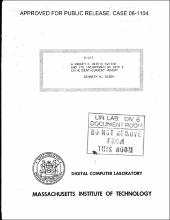A Magnetic Matrix Switch and its Incorporation into Coincident-Current Memory
Olsen, Kenneth H.

DownloadMC665_r12_R-211.pdf (10.06Mb)
Date
1952-06-06Abstract
The random-access memory is an important element of a high-speed digital computer. This memory must be capable of operating at high speeds with long-time reliability, and should be compact and of low cost. The coincident-current magnetic memory has been proposed as a possible device which has these qualifications. It was one of the original purposes of this theses research to prove experimentally the feasibility of a coincident-current memory of useful size. Since the distribution of the thesis report is limited and since the information it contains is of interest to the computer field, it is being issued as a Digital Computer Laboratory R-series report.
Although one of the features of this type of memory is the straightforward method by which the storage units are selected, there remains the switching problem associated with the selection and driving of its coordinate lines. Early in the research, the magnetic matrix switch was developed as a solution to this problem, and the thesis was broadened to include the proving of the practicability of using such a switch for selecting and driving the coordinate wires of a large coincident-current memory array.
The author is grateful to Mr. Robert Everett who supervised the thesis work, and to the staff members, technicians, draftsmen, and secretaries of the M. I. T. Digital Computer Laboratory for their invaluable aid during the research and preparation of the thesis report.